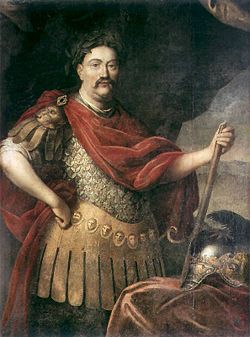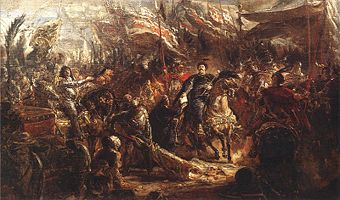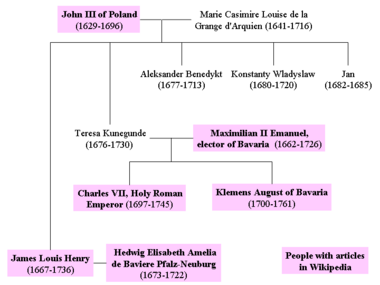John III Sobieski
| John III Sobieski | ||
|---|---|---|
 Jan III Sobieski in Roman costume. Detail of a 1686 painting by Jerzy Siemiginowski-Eleuter. |
||
| Born | August 17, 1629 | |
| in | Olesko, Poland | |
| Died | June 17, 1696 (aged 66) | |
| in | Wilanów, near Warsaw | |
| Reign | May 21, 1674 to June 17, 1696 |
|
| Coronation | February 2, 1676 in Wawel Cathedral, Kraków |
|
| Family or dynasty | Sobieski | |
| Coat of Arms | Janina. | |
| Parents | Jakub Sobieski Zofia Teofillia Daniłowicz |
|
| Marriage and children | with Marie Casimire Louise: Jakub Ludwik Sobieski Teresa Teofila Sobieska Adelaide Luise Sobieska La Mannone Sobieska Teresa Kunegunda Sobieska Aleksander Benedykt Sobieski Konstanty Władysław Sobieski Jan Sobieski |
|
| with French woman (mistress): Brisacier |
||
| with Lady Orchowska (mistress): child |
||
John III Sobieski, (Polish: Jan III Sobieski) (17 August 1629 - 17 June 1696) was one of the most notable monarchs of the Polish-Lithuanian Commonwealth, from 1674 until his death King of Poland and Grand Duke of Lithuania. Sobieski's 22-year-reign was marked by a period of the Commonwealth's stabilisation, much needed after the turmoil of the Deluge and Chmielnicki's Uprising. Popular among his subjects, he was also a brilliant military commander, most famous for the victory over the Turks in the 1683 Battle of Vienna. For his victories over the Ottoman Empire, he was dubbed by the Turks the "Lion of Lechistan."
Contents |
Royal titles
- Official title was (in Latin): Joannes III, Dei Gratia rex Poloniae, magnus dux Lithuaniae, Russiae, Prussiae, Masoviae, Samogitiae, Livoniae, Smolenscie, Kijoviae, Volhyniae, Podlachiae, Severiae, Czernichoviaeque, etc.
- Official title (Polish): Jan III, z łaski bożej, król Polski, wielki książę litewski, ruski, pruski, mazowiecki, litewski, kijowski, wołochyński, podlaski i czernichowski, etc.
- English translation: John III, by the grace of God King of Poland, Grand Duke of Lithuania, Ruthenia, Prussia, Masovia, Samogitia, Livonia, Smolensk, Kiev, Volhynia, Podlasie, Severia and Czernichow, etc.
Biography

Jan Sobieski was born 1629 in Olesko, a small town near Lwów (modern Lviv, Ukraine), to a notable noble family de Sobieszyn Sobieski of Clan Janina. His father, Jakub Sobieski, was the Palatine of Ruthenia and Castellan of Kraków; his mother, Zofia Teofillia Daniłowicz was a granddaughter of Hetman Stanisław Żółkiewski. After graduating from the Nowodworski College in Kraków, young Jan Sobieski graduated from the philosophical faculty of the Jagiellonian University. After finishing his studies, together with his brother Marek Sobieski (1628-1652), Jan left for western Europe, where he spent more than two years travelling. During that time he met major political figures: Louis II de Bourbon, Charles II of England and William II, Prince of Orange, and learned French, German and Italian, in addition to Latin. This proved to be vital during his later military career.
Both brothers returned to Poland in 1648 and volunteered for the army during the Chmielnicki Uprising. Jan founded his own banner of cavalry and commanded it in the rank of Rotamaster. After the Battle of Zborów, the brothers were separated and Marek died in Tatar captivity the following year. Jan was promoted to the rank of pułkownik and fought with distinction in the Battle of Beresteczko. A promising commander, Jan was sent by King John II Casimir to Istanbul in the Ottoman Empire as an envoy. There, Sobieski learned the Tatar language and studied the Turkish military traditions and tactics.
After the start of the Swedish invasion of Poland known there as "The Deluge", Jan Sobieski was among the Greater Polish regiments led by Krzysztof Opaliński, Palatine of Poznań which capitulated at Ujście, swearing allegiance to the Swedish king Charles X Gustav. However, in less than a year he returned with his unit to the Polish side, and after April 1656 he fought for the Polish king.
Commander

During the three-day long battle of Warsaw of that year, Sobieski brilliantly commanded a 2000 men strong regiment of Tatar cavalry, for which he was promoted to the title of Lord Standard-Bearer of the Crown. A strong supporter of the French faction, Sobieski remained loyal to the King during the infamous Lubomirski Rebellion, which also helped in his military career. In 1665 he married Marie Casimire Louise de la Grange d'Arquien and was promoted to the rank of Grand Marshal of the Crown and the following year to the rank of Field Hetman of the Crown. In 1667 he achieved another great victory over the Cossacks and their Tatar allies in the battle of Podhajce during the Polish-Cossack-Tatar War (1666-1671). A famed and much esteemed commander, in February 5, 1668 he achieved the rank of Grand Hetman of the Crown, the highest military rank in the Polish-Lithuanian Commonwealth and the de facto commander-in-chief of the entire Polish Army.
During the Polish-Ottoman War (1672-1676), on November 11, 1673 Sobieski added yet another brilliant victory to his list, this time defeating the Turks in the battle of Chocim and capturing the mighty fortress located there. The news of the battle spread across the country simultaneously to the news of the recent death of Michał I, King of Poland, who had died only a day before the battle. This made Sobieski one of the most popular personalities in the state and the following year, on May 19, he was elected the new monarch of the Commonwealth. The support of his candidacy was almost complete, with only a dozen or so members of the diet opposing him. Among the most notable partisans of his candidacy was his wife. Jan Sobieski was crowned Jan III February 2, 1676
King
Although Poland-Lithuania was at that time the largest and one of the most populous states of Europe, Sobieski became a king of a country devastated by almost half a century of constant war, which brought an end to Poland's economic well-being. The treasury was almost empty and the court had little to offer for the powerful magnates, who often allied themselves with foreign courts rather than the state they lived in. Sobieski decided to stabilise the situation of the country by forcing the Ottomans to accept a peace treaty to end the constant wars on the southern border. In the autumn of 1674 he recommenced the war against the Turks and managed to recapture the mighty fortresses of Kamieniec Podolski, Bar and Reszków, which re-established a strongly-fortified line defending Poland's southern border in the Ukraine. Polish historian Oskar Halecki and others noted, that Sobieski also planned to conquer Prussia with Swedish troops already approaching and with monetary French support. This secret pact, later exposed, was doomed because the war with Turkey took too long, by then the Great Elector had made treaties with France, the Swedes were repelled and by opposition from the Commonwealth's magnates, many of them on the Great Elector's side. Sobieski's plan was torpedoed by Michał Pac, the hetman of Lithuania and a supporter of Brandenburg, who simply defected with his army and disbanded it.

In 1675 the Tatars started a counter-offensive and crossed the Dneper, but could not retake the strategic town of Żórawno and the peace treaty was signed soon afterwards. Although Kamieniec Podolski remained a part of Turkey, Poland levelled its significance by the construction of the Stronghold of the Holy Trinity and return of the town of Biała Cerkiev. With signing of the treaty a period of peace started, much needed to repair the country and strengthen the royal authority. Although constantly harassed by the magnates and foreign courts of Brandenburg and Austria (Austria even tried to oust Sobieski and replace him with Charles of Lorraine), Sobieski completely reformed the Polish military. The military was reorganised into regiments, the infantry finally dropped pikes replacing them with battle-axes and the Polish cavalry adopted the formations of hussars and dragoons. Also, Sobieski greatly increased the number of guns and developed a new tactics of artillery.

As a diplomat, Sobieski envisioned an alliance of Poland with France and the Ottomans against the Austrian empire and Brandenburg. However, his plans never came true and finally in 1683 had to be completely abandoned. Conscious that Poland was risking a war against most of its neighbours similar to the Deluge and was lacking allies, Sobieski allied himself with Leopold I, the Holy Roman Emperor. The alliance, although aimed directly against Turks and indirectly against France, had the advantage of gaining support for the defence of Poland's southern borders.
In the spring of that year royal spies uncovered Turkish preparations for a military campaign, and Sobieski feared that the target might be the Polish cities of Lwów and Kraków. To prevent the risk, Sobieski started the fortification of the cities and ordered universal military conscription.
Sobieski's military prowess demonstrated in war against the Ottoman Empire contributed to his election as King of Poland. One of his ambitions was to unify Christian Europe in a crusade to drive the Turks out of Europe. He joined the alliance of the Holy Roman Emperor and joined the Holy League initiated by Pope Innocent XI to preserve Christendom.
Battle of Vienna

Sobieski's greatest success came on September 12, 1683 with his victory at the Battle of Vienna, in joint command of Polish, Austrian and German troops, against the invading Turks under Kara Mustafa.
Upon reaching Vienna, he joined up with the Austrians and Germans. Sobieski had planned to attack on the 13th of September, but with Turkish undermining efforts being close to succeeding, he ordered full attack on September 12. At 04:00 a united army of about 81,000 men attacked a Turkish army that numbered about 130,000 men which were divided between attacking the town walls and fighting off the united army. At about five o'clock in the afternoon, after observing the infantry battle from the hilltop, Sobieski led four husaria cavalry groups into a charge down the hillside. Soon, the Turkish battle line was broken and the Ottoman forces scattered in confusion. At 17:30, Sobieski entered the deserted tent of Kara Mustafa and the battle of Vienna was over.
The Pope and other foreign dignitaries hailed Sobieski as the "Savior of Vienna and Western European civilization." [1] In a letter to his wife he wrote, "All the common people kissed my hands, my feet, my clothes; others only touched me, saying: 'Ah, let us kiss so valiant a hand!'"
Later years
King Jan III Sobieski, nicknamed by the Turks the "Lion of Lehistan", and the last great king of Poland, died in Wilanów, Poland on June 17, 1696. His wife, Maria Kasimira, died in 1716 in Blois, France and her body was returned to Poland. They are interred together in Wawel Cathedral, Kraków, Poland.
King Jan III was succeeded by Augustus II who stayed in power primarily because of Russian support. On his death in 1733, a struggle for the crown of Poland ensued, referred to as the War of the Polish Succession.
Battles commanded by Sobieski
|
|
Portrayal of Sobieski's royal crown, Gdańsk.
|
Marriage and family

On July 5, 1665, he married the widow of Jan "Sobiepan" Zamoyski, Marie Casimire Louise de la Grange d'Arquien (1641-1716), of Nevers, Burgundy, France. Their children were:
- Jakub Ludwik, (b. 1667 - d. 1737) - Crown Prince.
- twin daughters (b. and d. 1669).
- Teresa Teofila (b, and d. 1670).
- Adelaide Luise (b. 1672 - d. 1677).
- daughter (b. and d. 1673).
- La Mannone (b. 1674 - d. 1675).
- Teresa Kunegunda, (b. 1676 - d. 1730) - In 1695, the Princess married Maximilian II Emanuel, elector of Bavaria.
- Aleksander Benedykt, (1677-1714).
- daughter (b. and d. 1678).
- Konstanty Władysław, (1680-1726).
- Jan, (1682-1685).
- daughter (b. 1691 - d. 1692).
- daughter (b, and d. 1694).
The family Sobieski
Ancestors
|
|
|
|
|
|
|
|
|
|
|
|
|
|
|
|
|
Jan Sobieski | ||||||||||||
|
|
|||||||||||||
|
|
|
|
|
|
|||||||||
|
|
Marek Sobieski |
|
|||||||||||
|
|
|||||||||||||
|
|
|
|
|
|
|
|
|
||||||
|
|
Katarzyna Gdeszyńska | ||||||||||||
|
|
|||||||||||||
|
|
|
|
|
|
|||||||||
|
|
Jakub Sobieski |
|
|||||||||||
|
|
|||||||||||||
|
|
|
|
|
|
|
|
|
|
|
|
|||
|
|
Jakub Snopkowski | ||||||||||||
|
|
|||||||||||||
|
|
|
|
|
|
|||||||||
|
|
Jadwiga Snopkowska |
|
|||||||||||
|
|
|||||||||||||
|
|
|
|
|
|
|
|
|
||||||
|
|
? Herburtówna | ||||||||||||
|
|
|||||||||||||
|
|
|
|
|
|
|||||||||
|
|
John III Sobieski |
|
|||||||||||
|
|
|||||||||||||
|
|
|
|
|
|
|
|
|
|
|
|
|
|
|
|
|
Stanisław Daniłowicz | ||||||||||||
|
|
|||||||||||||
|
|
|
|
|
|
|||||||||
|
|
Jan Daniłowicz |
|
|||||||||||
|
|
|||||||||||||
|
|
|
|
|
|
|
|
|
||||||
|
|
Katarzyna Tarło | ||||||||||||
|
|
|||||||||||||
|
|
|
|
|
|
|||||||||
|
|
Zofia Teofila Daniłowicz |
|
|||||||||||
|
|
|||||||||||||
|
|
|
|
|
|
|
|
|
|
|
|
|||
|
|
Stanisław Żółkiewski | ||||||||||||
|
|
|||||||||||||
|
|
|
|
|
|
|||||||||
|
|
Zofia Żółkiewska |
|
|||||||||||
|
|
|||||||||||||
|
|
|
|
|
|
|
|
|
||||||
|
|
Regina Herburt | ||||||||||||
|
|
|||||||||||||
|
|
|
|
|
|
|||||||||
Further reading
- Tatham, John Sobieski, (Oxford, 1881)
- Dupont, Mémoires pour servir à l'histoire de Sobieski, (Warsaw, 1885)
- Salvandy, Histoire de Pologne avant et sous le roi Jean Sobieski, (two volumes, new edition, Paris, 1855)
- Coyer, Histoire de Jean Sobieski, (Amsterdam, 1761 and 1783)
- Waliszewski, Acta, (three volumes, Cracow, 1684)
- Rieder, Johann III., König von Polen, (Vienna, 1883)
- Chełmecki, König J. Sobieski und die Befreiung Wiens, (Vienna, 1883)
- Du Hamel de Breuil, Sobieski et sa politique de 1674 à 1683, (Paris, 1894)
Trivia
- After World War II, a statue of Jan III Sobieski was "repatriated" to Gdańsk from the Ukrainian city of Lviv (Polish: Lwów, formerly in the Second Polish Republic). The statue overlooks a little park at the old Gdańsk City Hall museum.
- After the battle of Vienna, the newly identified constellation Scutum (Latin for shield) was originally named Scutum Sobiescianum by the astronomer Johannes Hevelius, in honour of Jan III Sobieski. While there are some few stars named after non-astronomers, this is the only constellation that was originally named after a real non-astronomer, who was still alive when the constellation was named.
- The legend of the origins of the bagel refer to Jan III Sobieski as the king to whom a Jewish baker gave the very first bagel in commemoration of a military victory in 1683. The round bagels were said to resemble the stirrups of Sobieski and his mounted warriors.
- Is putatively the great, great, great, great uncle of actress Leelee Sobieski.
- One of EuroCity trains connecting Warsaw with Vienna is named in his honor Sobieski.
Patronage
References
See also
|
John III Sobieski
House of Sobieski
Born: 17 August 1629 Died: 17 June 1696 |
||
| Regnal titles | ||
|---|---|---|
| Preceded by Stefan Czarniecki |
Field Crown Hetman of Poland 1666–1667 |
Succeeded by Dymitr Wiśniowiecki |
| Preceded by Stanisław "Rewera" Potocki |
Great Crown Hetman of Poland 1667–1674 |
Succeeded by Dymitr Wiśniowiecki |
| Preceded by Jerzy Sebastian Lubomirski |
Great Marshal of the Crown of Poland 1667–1674 |
Succeeded by Stanisław Herakliusz Lubomirski |
| Preceded by Michał Korybut Wiśniowiecki |
King of Poland 1674–1696 |
Succeeded by August II the Strong |
|
||||||||||||||||||||||||||
|
|||||||||||